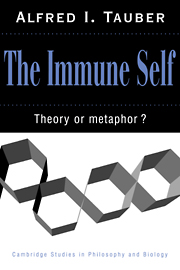Book contents
- Frontmatter
- Contents
- Acknowledgments
- Introduction
- 1 The phagocytosis theory
- 2 The triumph of immunology
- 3 The immune self declared
- 4 From theory to metaphor
- 5 Immunology gropes for its theory
- 6 The self and the phenomenological attitude
- 7 The self as organism: A philosophical consideration
- 8 The search for identity
- Notes
- References
- Index
5 - Immunology gropes for its theory
Published online by Cambridge University Press: 14 January 2010
- Frontmatter
- Contents
- Acknowledgments
- Introduction
- 1 The phagocytosis theory
- 2 The triumph of immunology
- 3 The immune self declared
- 4 From theory to metaphor
- 5 Immunology gropes for its theory
- 6 The self and the phenomenological attitude
- 7 The self as organism: A philosophical consideration
- 8 The search for identity
- Notes
- References
- Index
Summary
CONCERNING IMMUNITY AND COGNITION
Self, in its generic sense, is a complex metaphor used in immunology to signify those attempts to discern the source, the underlying root, of immunity. In scientific discourse self becomes the source from which immune activity arises to defend the organism against pathogens or endogenous deleterious or senile elements. But the self is not easily bounded and defined as an entity. As discussed in Chapter 4,1 refer to one usage as ontological, to suggest the essential quality of the inquiry, not to define an entity. By the very nature of the question of selfhood and the evasive nature of the referred subject we are situated at the elusive pole of the self metaphor. It is in the self-seeking, or selfdefining, process that the organism must emerge, and I use ontological broadly to refer to the admittedly nebulous quality of self-referential behavior. In this sense ontological refers not only to our view of the issue, but assumes the added dimension of the organism's own behavior. This usage, moreover, surreptitiously sets self outside reductionist discourse, fulfilling yet another aspect of my agenda. The transformation of self to a more experimentally fruitful and theoretically concrete usage (discussed in detail in this chapter) never completely absolves us from dealing with the elusive meaning of identity. In any case, as an articulated issue this is a relatively recent formulation. With respect to the organismic source, that is, the origin of immune identity, immunology was confronted with a novel problem.
- Type
- Chapter
- Information
- The Immune SelfTheory or Metaphor?, pp. 156 - 200Publisher: Cambridge University PressPrint publication year: 1994



